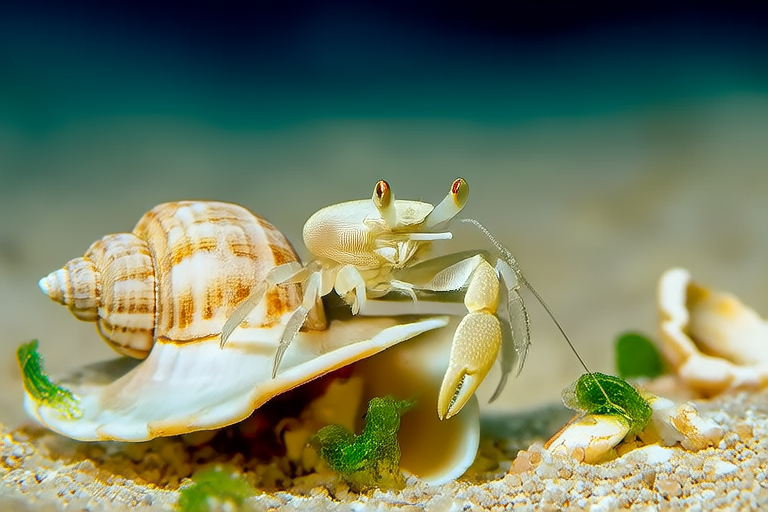Crustacean Companions: Revealing the Secrets of Pea Crabs
In the vast ocean, where mysteries abound, there exists a tiny yet intriguing inhabitant known as the pea crab. Despite their diminutive size, these crustaceans have captured the imagination of marine biologists and enthusiasts alike with their unique biology, symbiotic relationships, and fascinating behaviors. This article delves into the world of pea crabs, uncovering their secrets and shedding light on why they are worth our attention.
A Tiny Wonder: The Biology of Pea Crabs
Pea crabs (Pinnotheridae) are small, delicate creatures that belong to the superfamily Pinnotheroidea. They typically range from 2 to 3 centimeters in length, earning their name from their resemblance to the humble pea. Their bodies are flattened, which allows them to maneuver within the confines of their hosts. Unlike many other crabs, pea crabs lack claws, instead relying on their slender legs to move and manipulate objects.
Their exoskeletons are soft and pliable, enabling them to adjust to the shape of their host’s body cavity. This adaptation is crucial for their survival, as it prevents them from being expelled by their host. Interestingly, the coloration of pea crabs often matches that of their host, providing an additional layer of camouflage against predators.
Symbiosis: A Unique Relationship
One of the most remarkable aspects of pea crabs is their symbiotic relationship with various marine organisms. These crabs are obligate symbionts, meaning they cannot survive independently of their hosts. They have evolved to live inside the mantle cavities or gill chambers of bivalves such as clams, mussels, and oysters. Some species even associate with sea cucumbers, anemones, and echinoderms.
The relationship between pea crabs and their hosts is generally commensal, where the crab benefits without significantly affecting the host. In some cases, however, the interaction leans towards mutualism, where both parties benefit. For instance, while pea crabs feed on the host’s tissue, they also provide protection against parasites and predators, enhancing the host’s survival chances.
This intricate relationship has fascinated scientists for decades. Studies have shown that pea crabs can influence the reproductive success of their hosts. By consuming excess nutrients and waste products, they indirectly improve the water quality around the host, promoting better growth and development.
Habitat and Distribution
Pea crabs are found in a variety of marine environments across the globe. They prefer coastal waters, estuaries, and shallow seas, where their hosts thrive. These areas provide ample food sources and suitable conditions for both the crabs and their hosts. While they are predominantly found in temperate and tropical regions, some species have adapted to colder climates, expanding their distribution further.
The exact distribution of pea crabs is influenced by the availability of their hosts. As such, areas rich in bivalves and other potential hosts tend to support larger populations of pea crabs. Coastal regions with diverse marine ecosystems, such as those along the Pacific and Atlantic coasts, offer ideal habitats for these fascinating creatures.
Diet and Feeding Habits
The diet of pea crabs primarily consists of the soft tissues and fluids of their hosts. They use their mouthparts to rasp away at the host’s internal organs, extracting nutrients. This feeding method ensures a steady supply of food throughout their lives, as long as they remain within the host.
Additionally, pea crabs may supplement their diet with plankton and detritus found within the host’s environment. Their ability to adapt their feeding habits based on available resources highlights their resilience and versatility in different ecological settings.
Unique Behaviors
Pea crabs exhibit several unique behaviors that set them apart from other crustaceans. One of the most notable is their reproductive strategy. Female pea crabs lay their eggs within the safety of the host’s body cavity, ensuring protection for their developing offspring. Once hatched, the larvae are released into the surrounding water, where they must fend for themselves until they find a suitable host.
Mating behavior in pea crabs is equally fascinating. Male pea crabs often enter the same host as the female, establishing a monogamous relationship. This arrangement not only increases the likelihood of successful reproduction but also provides mutual protection against external threats.
Another interesting aspect of pea crab behavior is their ability to change hosts if necessary. If a host becomes too damaged or dies, pea crabs can leave and seek out a new one. This flexibility demonstrates their adaptability and resourcefulness in the face of changing environmental conditions.
Conservation Concerns
Despite their widespread distribution, pea crabs face several conservation challenges. The degradation of marine ecosystems due to pollution, overfishing, and climate change poses significant threats to their survival. As keystone species in many marine communities, the decline of pea crabs could have far-reaching consequences for the entire ecosystem.
Efforts to protect pea crabs and their habitats are essential for maintaining the balance of marine ecosystems. Awareness campaigns aimed at educating the public about the importance of these creatures can play a crucial role in fostering a sense of responsibility towards their conservation. Encouraging sustainable fishing practices and reducing pollution can also contribute to the preservation of pea crabs and their hosts.
By understanding and appreciating the unique biology, symbiotic relationships, habitat, diet, and behaviors of pea crabs, we can better advocate for their protection. Supporting research initiatives and participating in conservation efforts will ensure that these tiny companions continue to thrive in the vast ocean.
